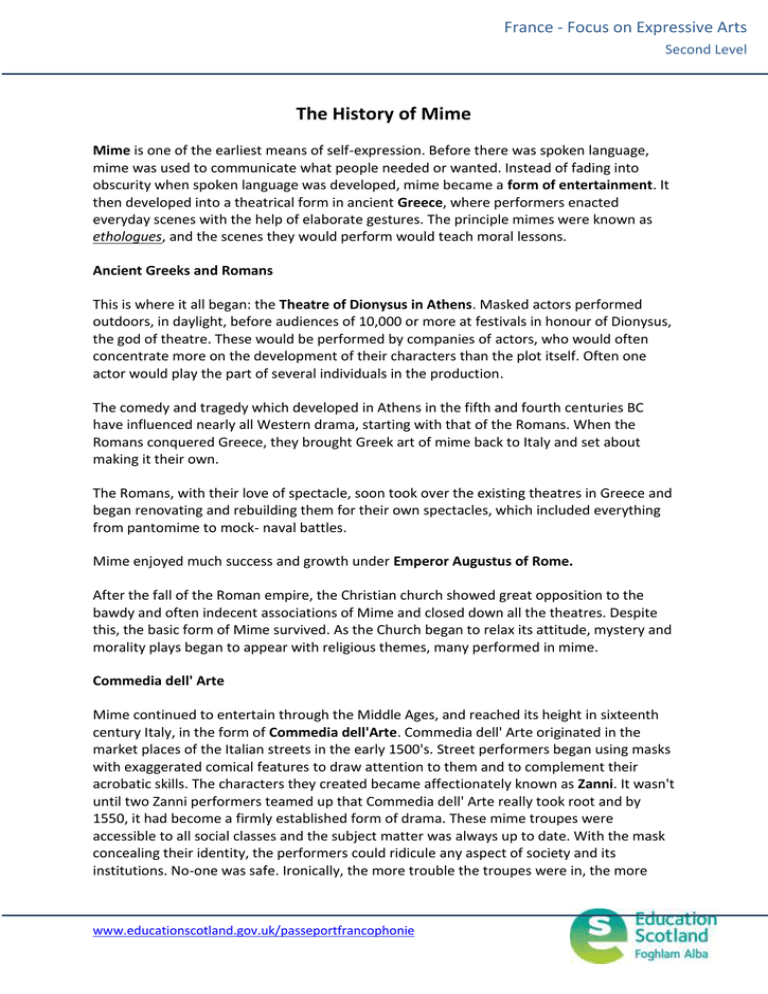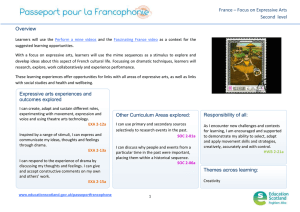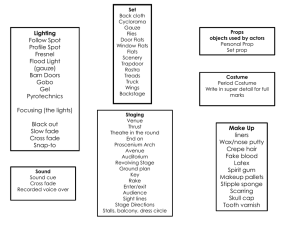The History of Mime France - Focus on Expressive Arts
advertisement

France - Focus on Expressive Arts Second Level The History of Mime Mime is one of the earliest means of self-expression. Before there was spoken language, mime was used to communicate what people needed or wanted. Instead of fading into obscurity when spoken language was developed, mime became a form of entertainment. It then developed into a theatrical form in ancient Greece, where performers enacted everyday scenes with the help of elaborate gestures. The principle mimes were known as ethologues, and the scenes they would perform would teach moral lessons. Ancient Greeks and Romans This is where it all began: the Theatre of Dionysus in Athens. Masked actors performed outdoors, in daylight, before audiences of 10,000 or more at festivals in honour of Dionysus, the god of theatre. These would be performed by companies of actors, who would often concentrate more on the development of their characters than the plot itself. Often one actor would play the part of several individuals in the production. The comedy and tragedy which developed in Athens in the fifth and fourth centuries BC have influenced nearly all Western drama, starting with that of the Romans. When the Romans conquered Greece, they brought Greek art of mime back to Italy and set about making it their own. The Romans, with their love of spectacle, soon took over the existing theatres in Greece and began renovating and rebuilding them for their own spectacles, which included everything from pantomime to mock- naval battles. Mime enjoyed much success and growth under Emperor Augustus of Rome. After the fall of the Roman empire, the Christian church showed great opposition to the bawdy and often indecent associations of Mime and closed down all the theatres. Despite this, the basic form of Mime survived. As the Church began to relax its attitude, mystery and morality plays began to appear with religious themes, many performed in mime. Commedia dell' Arte Mime continued to entertain through the Middle Ages, and reached its height in sixteenth century Italy, in the form of Commedia dell'Arte. Commedia dell' Arte originated in the market places of the Italian streets in the early 1500's. Street performers began using masks with exaggerated comical features to draw attention to them and to complement their acrobatic skills. The characters they created became affectionately known as Zanni. It wasn't until two Zanni performers teamed up that Commedia dell' Arte really took root and by 1550, it had become a firmly established form of drama. These mime troupes were accessible to all social classes and the subject matter was always up to date. With the mask concealing their identity, the performers could ridicule any aspect of society and its institutions. No-one was safe. Ironically, the more trouble the troupes were in, the more www.educationscotland.gov.uk/passeportfrancophonie France - Focus on Expressive Arts Second Level popular and successful they became. Even though troupes travelled away from their homeland, language was no barrier. Skilful mime and Zanni antics conveyed the story lines to audiences throughout Europe. So strong was their influence that performers from other countries began to imitate the Zanni style. In 1576, a company of Italian players led by Flamino Scala went to France, where the art of Mime became immensely popular. Many of the traditional gestures and figures, such as Harlequin, became familiar at this time. Modern Mime Almost two and a half centuries later, in 1811, a Bohemian acrobatic family were playing in Paris. The son of the family, Jean-Gaspard Baptiste Deburau, was engaged to perform at the Funambules on the Boulevard du Temple. He remained at this Theatre until his death and during this time, he converted the crude slapstick form of Mime to the art form that it is known as today. Deburau was a master of his art and was responsible for creating the lovesick 'Pierrot', the eternal seeker. Mime received new impetus after the First World War from the great Jacques Copeau, who, together with his own pupil Jean-Louis Barrault, developed the first elements of modern mime. After the Second World War, Marcel Marceau emerged as a great mime artist. He created his own special character, known as 'Bip', who is a familiar sight, wearing his top hat with the flower sticking out and his short jacket. Bip was a character similar to Pierrot, a down trodden character, who could sometimes win but would always end up at the bottom of the ladder. Influenced by the silent film stars like Chaplin and Keaton, Marceau was the architect of a totally new style and tradition, the true creator and master of modern mime as we understand it today. Basically, there are two major types of mime: literal and abstract or a combination of both. These types are evident in all the schools of mime. Literal mime is primarily used for comedy and story theatre. Literal mime generally tells a story with a conflict, through the use of a main character. The actions and visual design clearly tell the viewers the story, which is usually humorous. Abstract mime is used to generate feelings, thoughts and images from a serious topic or issue. Normally, there is no plot or central character. It is considered a more intuitive experience or image rather than literal actions. Videos: - Facial expressions are key to the mime sequences in this video clip of world famous mime artist, Marcel Marceau. - Some really clever and exciting mime skills are used by this modern artist in this www.educationscotland.gov.uk/passeportfrancophonie France - Focus on Expressive Arts Second Level video. www.educationscotland.gov.uk/passeportfrancophonie





